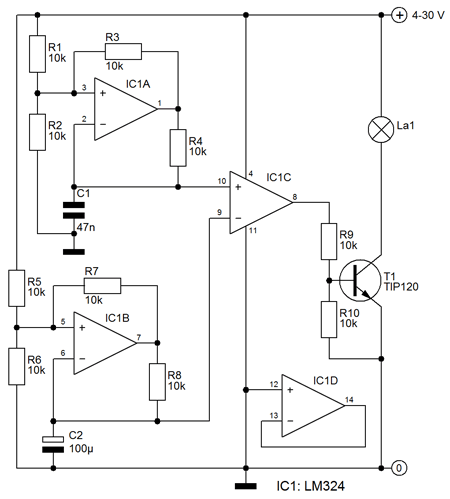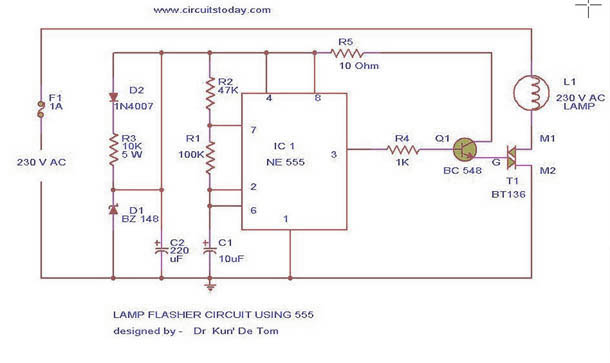
Smooth FlasherCircuit

Standard LED flashers activate the LED in a rapid on-off sequence, which can become bothersome over time. The circuit presented here offers a more gradual illumination effect.
This circuit utilizes a simple design to create a soft flashing LED effect, which is less jarring to the eyes compared to traditional LED flashers. The primary components include a resistor, a capacitor, and a light-emitting diode (LED).
The operation begins when the circuit is powered. The capacitor charges through the resistor, and as the voltage across the capacitor increases, it eventually reaches the forward voltage threshold of the LED, causing it to illuminate. As the LED lights up, the capacitor begins to discharge, leading to a gradual dimming of the LED until it turns off completely. This process repeats, creating a smooth fade-in and fade-out effect.
The values of the resistor and capacitor can be adjusted to modify the timing of the LED's flashing rate. A larger capacitor will take longer to charge and discharge, resulting in a slower flash rate, while a smaller capacitor will produce a quicker cycle. Similarly, the resistor value affects the charging time; a higher resistance will slow down the charging process, thus extending the duration of the LED's illumination.
This circuit is particularly useful in applications where a gentle visual cue is preferable, such as in decorative lighting or as an indicator light in devices where harsh flashing can be distracting or uncomfortable for users. Overall, the gentle LED flasher circuit provides an aesthetically pleasing alternative to standard LED flashers, enhancing user experience through its soft illumination.Ordinary LED flashers turn the LED on and off abruptly, which can get a little irritating after a while. The circuit shown here is more gentle on the eyes.. 🔗 External reference
This circuit utilizes a simple design to create a soft flashing LED effect, which is less jarring to the eyes compared to traditional LED flashers. The primary components include a resistor, a capacitor, and a light-emitting diode (LED).
The operation begins when the circuit is powered. The capacitor charges through the resistor, and as the voltage across the capacitor increases, it eventually reaches the forward voltage threshold of the LED, causing it to illuminate. As the LED lights up, the capacitor begins to discharge, leading to a gradual dimming of the LED until it turns off completely. This process repeats, creating a smooth fade-in and fade-out effect.
The values of the resistor and capacitor can be adjusted to modify the timing of the LED's flashing rate. A larger capacitor will take longer to charge and discharge, resulting in a slower flash rate, while a smaller capacitor will produce a quicker cycle. Similarly, the resistor value affects the charging time; a higher resistance will slow down the charging process, thus extending the duration of the LED's illumination.
This circuit is particularly useful in applications where a gentle visual cue is preferable, such as in decorative lighting or as an indicator light in devices where harsh flashing can be distracting or uncomfortable for users. Overall, the gentle LED flasher circuit provides an aesthetically pleasing alternative to standard LED flashers, enhancing user experience through its soft illumination.Ordinary LED flashers turn the LED on and off abruptly, which can get a little irritating after a while. The circuit shown here is more gentle on the eyes.. 🔗 External reference

